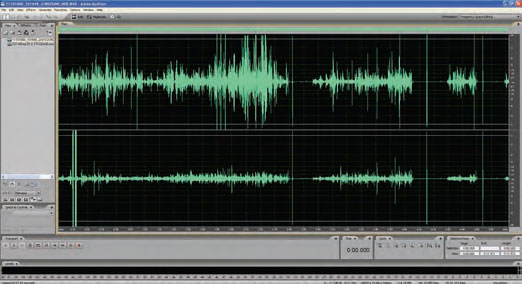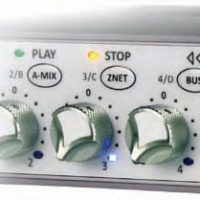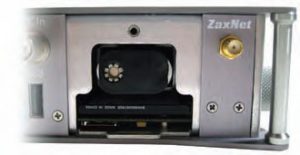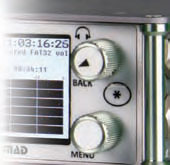RE-PRINTED WITH PERMISSION from Sound & Picture.
 Manufacturers await my reviews of their products with a bit of anxiety because they know I’m going to filter out the sales talk and tell it like it is for the benefit of the end-users. That’s probably why I’ve been asked so many times what I think about the new Zaxcom Nomad mixer/recorder.
Manufacturers await my reviews of their products with a bit of anxiety because they know I’m going to filter out the sales talk and tell it like it is for the benefit of the end-users. That’s probably why I’ve been asked so many times what I think about the new Zaxcom Nomad mixer/recorder.
So what do I think? I think the Nomad represents the future of compact mixer-recorders that are made for professional audio field production. I predict that other manufacturers will follow, just like the entire industry joined the market created by Zaxcom’s Deva line of hard drive recorders.
Zaxcom has an uncanny crystal ball-like ability to see where we are going even before we see it ourselves. That’s why many of the things that seemed so foreign to us a decade ago when Zaxcom President, Glenn Sanders, was explaining his new machines, are now taken for granted. Maybe because Zaxcom can see the future so clearly, there has been a tendency to talk about the future as if it were the present, promoting features that are actually still on their “to do list”. But it is important to not let that detract from the remarkable abilities of Zaxcom’s mixers and recorders, and their proven ability to deliver what they promise. For example, when the Deva 4 and Deva 5 were first introduced by Zaxcom years ago, there were still things on their to do list. But the list was eventually finished (OK… except for “playback-while-recording”), and many additional and very valuable features were added over the years with free firmware revisions. The vast majority who took the plunge will now attest that they bought the right machine. Zaxcom’s prediction and commitment to the concept that fully microprocessor-based mixer/recorders would have a longer and more useful lifespan than their hardware-based competition, turned out to be spot-on.
NOTE: This review is not intended to be a complete list of features or specifications. The intention is to describe the more interesting things about the Nomad in a way that is relevant to those in the profession of sound for film and video production.
The Nomad is billed by Zaxcom as the ultimate in ultra-compact mixer/recorders. Is it?
When the criteria is number of inputs and outputs, signal routing ability, monitoring versatility, feature set, effects package (EQ, filters, compression, delay, etc), compact size, high quality audio, and competitive price, the Nomad must, indeed, be the ultimate in ENG mixers. Even if the recorder section of the Nomad is not needed for a particular production, it is still the most capable ENG-style field mixer available. Likewise, if the Nomad is the primary recorder, there is no need to have an external ENG mixer. As a recorder, since it has nearly the same capabilities as the other time-proven Zaxcom Deva and Fusion machines, it has to also be considered as being among the best portable multi-track recorders.
As a Mixer
Its uncluttered front panel has a total of only eight knobs, and conceals the fact that in a one-piece device of its size, nothing comes close to the mixing abilities of the Nomad.
It has 18 inputs in the following configuration:
6 analog mic/line
4 Analog Line
6 AES
2 AES 42

6 Analog Mic/Line Inputs

6 AES

2 AES 42
All of these inputs can be routed in any combination, prefader or to any or all of the 6 panel faders and 4 virtual on-screen faders – to any combination of 16 outputs, simply by clicking on a box in the bright color display. The list of what you can do with all those inputs on their way to all those outputs includes HPF (high pass filter), notch filters, delay, and compress/limit. In addition to these inputs and outputs are the SLATE and COM circuits using an internal or external slate mic that can also be routed to the various outputs, including 2 headphone jacks (on separate buss circuits). A promised (but not yet available) feature called Auto Mix could prove to be a very valuable tool for the large numbers of microphones used on unscripted productions like reality television. A unique feature called “ZaxNet” is also promised soon, which uses an internal 2.4G transmitter to remote control Zaxcom wireless transmitters (frequency, ON/SLEEP, and gain). ZaxNet is not yet functional on the Nomad, but it has been in use on the Deva and Fusion recorders for years.
There are plans for the Nomad to be compatible with the Zaxcom Mix-8 control panel, which will give it vertical faders and trim knobs in a very compact chassis, ideal for highly portable desk-style mixing. The Mix-8 panel has already been in use for several years with the Deva and Fusion recorders, so it’s safe bet that the Mix-8 software will soon be written for the Nomad.
A patent-pending feature called “Never Clip” is unique to the Nomad and worthy of explanation because it is both a valuable and confusing feature. Never Clip, for all practical purposes, prevents the input stages of the Nomad from exceeding digital max. Never Clip allows an additional 20dB of level beyond 0dBfs at the input, without actually reaching the input’s A-D converters’ digital max. Do not confuse this as a limiter function, because there is no limiting or compressing in Never Clip. Also, do not confuse this as a feature that prevents a recording track from clipping when driven past 0dBfs. It seems that this is done by transitioning from one digital converter to another that is offset by 20dB, but it seems to do this seamlessly and inaudibly. What this means is that if, for example, the level from a microphone goes higher than the trim was set to accept (high enough to exceed 0dBfs of the input’s digital converters), there will still be no input distortion. In this situation, all that’s needed to prevent the postfader mix track from distorting is to turn down the fader knob low enough to prevent this signal from being recorded beyond 0dBfs (max). You may have to turn down the fader to 9:00 while still reaching full scale on the recording track, but it will not distort. Keep in mind that any prefader isolation tracks will be subject to overload because they are not being turned down by the fader. For this reason, it makes sense to use the track limiters to prevent overload of the prefader isolation tracks. The limiters are “soft knee” type with variable threshold, ratio, attack and release times that do not sound obvious when working. Once this process is understood, the Never Clip feature can be very valuable. The Never Clip feature is always in place so there is no menu selection for it.

Neverclip in Action

Auto Trim’s Blue Indicator
Another unique feature of the Nomad is called “Auto Trim”, designed to give instant access to the trim control of each fader. When this feature is selected, slightly moving a fader will turn on a blue light next to the fader, indicating that Auto Trim is active on that input. When the blue light next to a fader is on, this means that turning the MENU knob will adjust the trim up or down. It’s true that this feature makes trim adjustments very fast, and sometimes even faster than a traditional trim knob. However, I fear that having this feature active while working from a bag will make it too easy to unintentionally adjust the input trims. To adjust the Nomad trims manually, press the SETUP button, select TRIM, then turn the MENU knob to raise or lower the level. In practice, I have found this method on the Deva to be fast enough for most real-world, and the Nomad is even quicker. Plus, with the Never Clip feature, the need for the trims is significantly reduced.
Another example of how the Nomad can be customized by the user includes the “shifted” and “unshifted” transport option (“transport” being a reference to antique tape recorders). In “shifted” mode, the transport functions of RECORD, PLAY, STOP, etc, are only active while holding down the MENU button (which serves as a “shift” key). This prevents accidentally putting the Nomad into record, or, worse, accidentally taking it out of record. At first I wasn’t a fan of this “shifted” feature, particularly as the default setting, but this was probably due to my frustration and embarrassment from not being able to figure out how to put it into record. But now that I’ve spent a lot of time with the Nomad, I have to admit that Zaxcom was right, and it would now be my standard setting. I still believe that the default setting for new-in-the-box Nomads should be the “unshifted” mode so that when the new owner presses record, it will go into record. But once it is understood, I would probably choose the shifted transport option. While I can’t take up the space to list all of the customizable options, suffice it to say that nearly every function of the Nomad can be customized by the user for a better fit to their way of working.
As a Recorder

CF Card located in battery compartment
The Nomad is available in four models: the 4, 6, 8, and 12, which basically refers to the number of available recording channels. Otherwise, the basic recording functions are shared with each model. The price increases with each model number, but every model can be upgraded to a higher model with a paid firmware revision. All of the models have an internal timecode generator with the various frame rate options used today. Like the previous larger recorders from Zaxcom (the Deva and Fusion), the Nomad records to its primary media (a CF card) with the Zaxcom proprietary file type “MARF” (Mobile Audio Recording Format). These files are then converted to BWF files when mirroring onto its second CF card slot, which is intended to normally be the main deliverable. This process can be chosen by the user to happen simultaneously in the background, or automatically when “STOP” is pressed, or can begin whenever the user manually chooses. There are multiple advantages to the MARF system, which include reliability, but also has the ability to retain the recording right up to the moment of a power loss. But an even more practical advantage I’ve found in this system is that the files copied onto deliverable media (typically CF card) can have a number of different parameters determined AFTER the original recording is made. For example, mirrored copies can be made that are BWF-Poly, BWF-Mono, -F mode, etc, and it’s nice to be able to change these choices after the original recording is made. I should say that this process is not unique to the Nomad, but is unique to Zaxcom recorders, and proven to be an asset.
The fact that the Nomad is so compact makes it a little less user-friendly than the larger Deva and Fusion recorders. Deva and Fusion owners will find themselves, out of habit, trying to press the Nomad screen. But instead, of a touch screen, its smaller but nice, bright, color display relies on button presses and a scroll knob to navigate and select the menu options. However, once you become familiar with the menu layers, it is quite fast. Otherwise, There are a few promised features that are still being developed, but – as is – I feel it is ready now to enter the ENG location recording world.

Mirror Recording Available
When assigning to the available recording tracks, the recording media (main card or mirror card or USB device) is treated like any other of the mixer’s destinations. This is an important point about the Nomad’s versatility, which allows individual mixes and track configurations to be sent to each recording media and other devices such as cameras, backup recorders, EPK crews, video assist, production Comteks, etc. Another way to explain this is to say that, in addition to all of the outputs mentioned above in the mixer paragraph, there are additional “outputs” used to feed the internal main recorder and mirror media.
As predicted by Zaxcom years ago to a disbelieving industry, metadata is now an important and expected part of our production sound tracks as our post production colleagues grow to depend on them more. So, the Nomad has full metadata capability. While the Nomad handles text entry fast enough for most productions, and makes great use of its bright easy-to-read screen and navigation knobs, it is no match for the ease and speed of the large touch screen used by the Deva and Fusion recorders. But, still, text is surprisingly easy to enter given the small-ish size of the Nomad screen, and easy enough to be usable in most production scenarios.
Overall Design
Zaxcom’s layout and style has reached a respectable level with the Nomad. The front control panel is a glossy waterproof overlay that’s reverse printed with text that can never rub off. The knobs are attractive with a bright machined and knurled metal finish with a pointer that makes them easy to feel their positions without looking at them, and have a recessed area for the supplied color coding stickers for when you can look at them. The primary XLR input connector panel is in the back of the chassis, but recessed so that input cables will not take up any space in a bag, and will not have to support the weight of the device when positioned vertically.
This heightened level of design needs to be acknowledged because Zaxcom has taken a fair amount of criticism over the years for the lack of aesthetic appeal of their earlier devices. Some will say that these improvements are largely due to design elements inspired by the design of competing manufacturers. While there may be some truth to this, it is also true that the concepts of Zaxcom mixer/recorders have been the primary inspiration of every competing device.

Headphone Knob
In the “fit and finish” department there are two items that will be noticed right away.
First, the headphone level knob (that also doubles as the “back” button for menu screens) has a noticeable wiggle to it. Most people will assume that the knob is loose on the shaft, but it’s actually the shaft that wiggles inside the control. This is normal for this control – the headphone volume knob on all Nomads do it. The item is the point at which the top cover it meets the back panel; it is easily flexed because it doesn’t have much support. It may never cause a problem, but it is not confidence inspiring, and it would be good if it were addressed. Another thing about headphone knob that would not be discovered until it’s too late is that the shaft hole is drilled too deep, which, if the set screw loosens, allows the knob to slide down onto the panel. The problem is that this control also has a push switch function for clicking through different menu options, and if the knob slides down to the panel, you can’t push the switch to change menu screens. Glenn Sanders might kick me, but I can’t resist calling this condition “Never Click”. Oh well, no one reads this far down anyway, do they? Seriously, having the knob slip like this could put the Nomad into lock-down, so I recommend keeping the proper size Allen wrench in your kit for this knob’s setscrew (you should do this anyway for all mixers), and, better still, remove the headphone knob and shim the hole with something like a thin washer or a small wad of aluminum foil so that when the knob cannot be pressed against the panel. Zaxcom is aware of this issue and I’m told has changed the remaining knobs, but I know that quite a few Nomads were delivered with knobs that have this potential problem.
Summary
The Deva and Fusion machines still lead the pack when it comes to cart-based production, which is how it should be because the Nomad was never intended to replace them. But when the need is for a smaller, less expensive, and ultra capable mixer/recorder for very portable film/video production sound, the new inspiration for this market is, no doubt, the Nomad.

One comment
Leave a reply Delete Message
You must be logged in to post a comment.


 US
US  Canada
Canada 

When it comes down to not cheap, The Island does not joke.
Butt trutth to tell if I had tthe funds then I Am pretty sure I would be snorkel diving iin
Ala Moana or cooping at Yokohama. It iis better
han dealing with the latest ice storm.